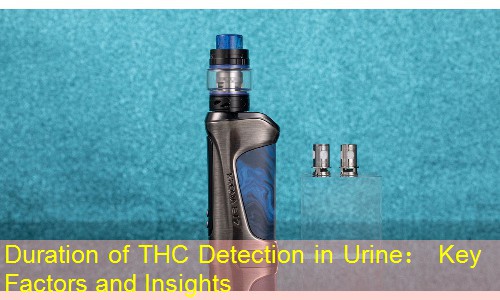Understanding the Detection of THC in Urine: A Comprehensive Overview

The increasing popularity of cannabis-related products, particularly vape pens, has led to heightened interest in the implications of their use on drug testing. For individuals who partake in vaping cannabis, a common concern is the duration that tetrahydrocannabinol (THC) can be detected in urine. This article delves into the factors affecting THC metabolism, detection windows, and suggests best practices for individuals concerned about urine drug tests.
Factors Influencing THC Metabolism
When considering how long cannabis remains detectable in urine, several factors come into play.
Frequency of Use
is one of the most significant determinants. Occasional users may find THC metabolites clear from their systems within several days, while regular users can expect a much longer detection window, potentially lasting several weeks to even months.
Another crucial factor is
Body Composition
. THC is fat-soluble, meaning it binds to fat cells in the body. Individuals with higher body fat percentages are likely to retain THC metabolites longer than those with lower body fat. Additionally,
Metabolic Rate
plays a role; individuals with a faster metabolism may process THC more quickly, leading to shorter detection times compared to those with slower metabolic rates.
Detection Windows for Urine Tests
Urine tests are the most common form of drug screening for THC, and their detection windows vary for different user types. For
Occasional Users
(those who consume cannabis less than once a week), THC can typically be detected for up to three days after use. However, this duration can be influenced by factors such as hydration levels and individual metabolism.
For
Regular Users
(those who consume cannabis multiple times a week), the detection window can extend significantly. Regular use may lead to detectable levels of THC in urine for 10 to 20 days after last use. For
Chronic Users
(daily or near-daily consumers), detection can persist for over a month, with some reports indicating detection up to 45 days after the last use.
THC Metabolites: The Role They Play
In understanding how long THC can be detected in urine, it is essential to know about its metabolites, primarily THC-COOH.
Metabolite Formation
occurs when THC is broken down in the body, and this metabolite remains detectable long after the effects of the substance wear off. Drug tests typically look for these metabolites, which complicates the ability to determine recent use versus past consumption.
Best Practices for Preparing for a Drug Test
For those who may have concerns about upcoming drug tests, there are several best practices that can be implemented to reduce the likelihood of detection. Staying
Hydrated
is one key practice, as increased water intake can help flush out metabolites. It is essential to ensure hydration is balanced and does not lead to extreme dilution, which could raise suspicion during testing.
Incorporating
Exercise
into one’s routine can aid in metabolizing fat stores, assisting in the elimination of THC metabolites from the body. As THC is stored in fat cells, engaging in regular physical activity can help reduce overall THC levels more swiftly.
Finally,
Dietary Considerations
should not be overlooked. Consuming a healthy, balanced diet rich in fiber can aid the body’s natural detoxification processes. Foods such as fruits and vegetables can support metabolism, potentially speeding up the clearance of THC metabolites from the system.
Conclusion: Navigating the Complexities of Cannabis Use and Drug Testing
In conclusion, the duration that cannabis vape pen usage remains detectable in urine is influenced by a multitude of factors, including frequency of use, body composition, and metabolic rate. For occasional users, the timeframe is relatively short, potentially lasting a few days, while regular and chronic users may face detection periods spanning weeks to over a month. Understanding these dynamics empowers users to make informed choices about their consumption and navigate drug testing with greater confidence.














